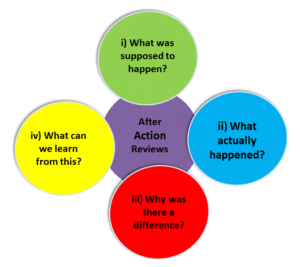After action reviews – and how they can be linked with ToCs to support strategic thinking
This post introduces After Action Reviews (AARs), and indicates how theories of change and AARs can be used in tandem to create both the space and guidance for strategic learning, and subsequent adaptation and innovation.
The importance of reflecting on what you are doing, as part of the learning process, has been emphasized by many reviewers. Building the capacity to reflect on action so as to engage in a process of continuous learning is increasingly seen as an important aspect of behavior change, and it is beginning to be used in many models of changing professional practice. However, it is not a conscious behavior for many teams, and effort needs to be put in to provide teams with tools that can support reflection. These tools are usually known under names such as After Action Review (AAR) or Learning Debriefs, and are used by to capture the lessons learned from past successes and failures, with the goal of improving future performance.
In terms of evaluation they are starting to be paired with design processes such as program theory-based approaches. Developing results-based framework diagrams can help with structuring and deepening participants thinking and planning (both in developing action plans and monitoring plans) for a project. Then after these plans have been implemented (action), an AAR can provide people with a platform and space to reflect on what happened and what they are learning about their project.

AAR is a form of group reflection; participants review what was intended (activity aims), what actually happened (intended and unintended outcomes), why it happened and what was learned. AARs should contribute to information that not only helps assess an immediate activity, but also helps assess progress towards longer-term term progress set out in the underlying Theory of Change (TOC) and accompanying logic models. AARs can be used in short, frequent group process checks, or more extended, in-depth explorations to assess progress at the wider level. It can be undertaken by a group or an individual as they ask themselves four questions:
- What was supposed to happen? By asking each participate about their expectations it can sometimes highlight problems in communication as individuals have different expectations.
- What actually happened? By identifying what went on an accurate picture can be built up.
- Why was there a difference? This is where participants need to concentrate on the what – and not the who – between expectations and what actually happened.
- What can we learn from this? What learning points have been identified so that the organisation or individual continues to improve?
AARs can be conducted almost anywhere, and will vary in length. For example, an AAR can be conducted after a one-off event (in 15 minutes or so), or a much more focused meeting could be held to reflect on how planned intermediate and longer-term outcomes are being achieved at an organizational or program level. It is important that the underlying culture of those undertaking an AAR is one of openness and learning. It is not about allocating blame, but ensuring that those involved can move forward (and adapt where necessary). Lessons are not only shared by the individuals involved but can be documented and shared with a wider audience.
Every organization, every partnership or team, and every intervention will likely require different levels of preparation, execution, and review. However, a number of best practices do emerge across the literature:
- Lessons must first and foremost benefit the team that develops them. The AAR process must start at the beginning of the activity (with clear aims set out in advance through a TOC or outcomes modeling process). AAR Lessons must link explicitly to future actions, that support desired outcomes. And leaders must hold everyone, especially themselves, accountable for learning.
- Managers and facilitators should phase in an AAR culture. This can begin with facilitating simple AARs around team projects – keeping things simple at first and developing the process slowly—adding knowledge-sharing activities and systems, richer metrics, and other features dictated by the particular initiatives in question.
- If there are issues with either openness or time, it may be worthwhile to gather individual ideas first – and then facilitate a group discussion.
By creating tight feedback cycles between planning and action, AARs build team and organizational capacity to succeed in a variety of conditions. AARs are not just a source of lessons, but provide a low-technology tool which teams and communities can use on how to draw new lessons from novel and evolving situations for which they did not train—situations they may not even have imagined. In a fast-changing environment, the capacity to learn lessons and adapt can be more valuable than any individual lesson learned. That capacity -which can be used for adaptive management or for innovation – is what can be gained by more closely linking outcome planning and learning-based reflective activities such as AARs.
A number of other Learning for Sustainability pages provide additional information on this topic. The page on selecting evaluation questions and types directly builds on this topic and includes links to additional external resources. A number of other pages are introduced through to the introductory page titled Planning, monitoring & evaluation – closing the loop.
An independent systems scientist, action research practitioner and evaluator, with 30 years of experience in sustainable development and natural resource management. He is particularly interested in the development of planning, monitoring and evaluation tools that are outcome focused, and contribute towards efforts that foster social learning, sustainable development and adaptive management.

This resonates with my experience in the CGIAR Research Program on Aquatic Agricultural Systems. As you say, AARs are useful to learn after implementing plans derived from a theory of change. In my experience the insight adds detail under the existing theory of change rather than challenge its underlying causal assumptions that are usually at a higher scale.